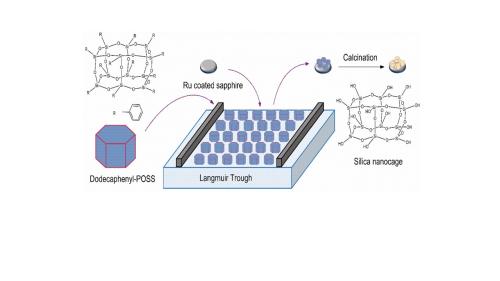Technologies Available for License
Categories: advanced materialsnanotechnology
2019-009: Metal-supported Silica Nanocages for Trapping Noble Gases
Invention: 2019-009
Patent Status: U.S. Patent Number 12,005,391 was issued on June 11, 2024
For technical and licensing related questions, email tcp@bnl.gov.
Summary

Scheme: Schematic of the approach to deposit silica nanocages on the Ru film, using a Langmuir trough. The deposited cages are calcined after the deposition to remove the organic component.
Noble gases are valuable and scarce and these gases (e.g., Xenon (Xe)) used in various applications, including lighting, electronics, and anesthetics, and many others. Its low concentration in the atmosphere and the energy cost of purification makes noble gases expensive. Finding efficient ways to trap and separate it from other gases can have important implications.
Description
Brookhaven and SBU researchers have developed a novel material architecture made up of silicate nanocages in contact with a metal surface and a method for trapping single Xe atoms in these cages. The trapping is done at low Xe pressures and temperatures between 400 and 600 K, and the process is monitored in situ using synchrotron-based ambient pressure X-ray photoelectron spectroscopy. Release of the Xe from the cages occurs only when heating to temperatures above 750 K. A model that explains the experimental trapping kinetics is proposed and tested using Monte Carlo methods.
Benefits
The gas trapping assembly described is capable of trapping noble gas atoms with an ultrahigh desorption energy barrier. However, the trapped gases could then be selectively released by heating the materials to different temperatures depending on the gas under study thus allows for efficient gas separation or purification of the target noble gas.
Applications and Industries
This method of trapping noble gas has many potential applications including Xe production, generation of medical isotopes, reduction of radioactive noble gas emissions in nuclear power plants, testing devices in nuclear non-proliferation applications, electron emitters, and gas separation.
Journal Publication & Intellectual Property
Contacts
-

Poornima Upadhya
Manager Technology Transfer & Commercialization
Technology Commercialization
(631) 344-4711, pupadhya@bnl.gov
-

Avijit Sen
IP Licensing & Commercialization
Technology Commercialization
(631) 344-3752, asen@bnl.gov




